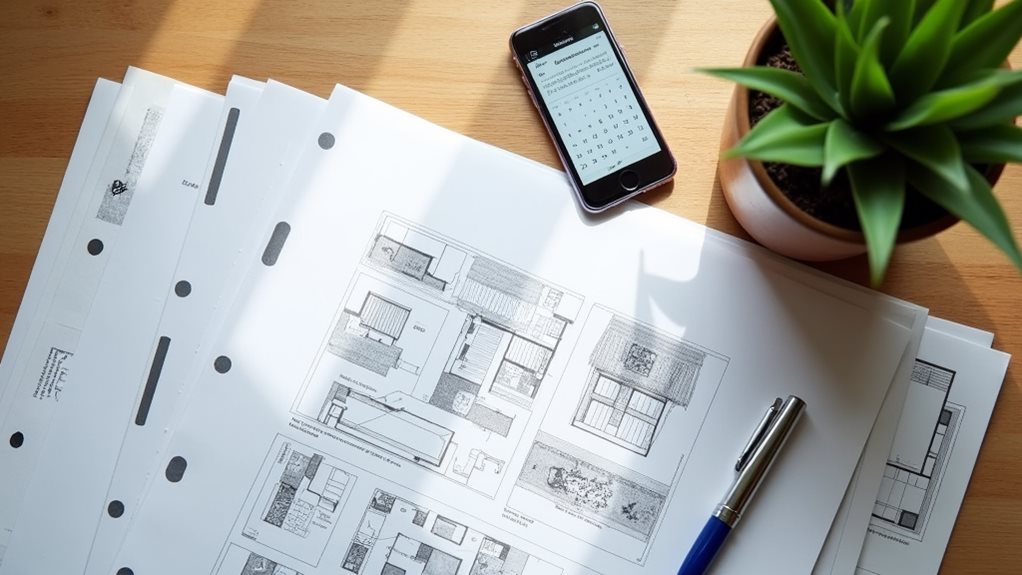Phone:
(701)814-6992
Physical address:
6296 Donnelly Plaza
Ratkeville, Bahamas.

Keep your home extension dreams on track by mastering the planning permission timeline in Manchester; discover the steps you need to take next.
Steering through the home extension planning permission timeline in Manchester can feel intimidating, but it's quite manageable. You'll want to start by ensuring your proposal meets local guidelines and gathering all required documents, which typically takes 1-2 weeks. Once submitted, expect about 3-4 weeks for public consultation. After that, the decision process usually ranges from 8 to 13 weeks, depending on complexity. If objections arise, there's a 21-day period for community feedback. If you receive approval, understanding the specific conditions is vital for moving forward. Stick around, and you'll uncover more essential tips for your project!

Understanding planning permission requirements is vital for anyone looking to extend their home. It's not just about upgrading your space; it's also about ensuring you're compliant with local policies.
If your property is a flat or a maisonette, you won't enjoy any permitted development rights and will need to seek full planning permission.
Think about size and location—extensions that exceed specific thresholds or sit too close to your boundaries may trigger a need for permission. Have you made previous changes to your home? Those could impact your current permitted development rights.
Additionally, if your property is located on designated land or in a protected area, you may face stricter regulations. It's important to stay informed about the unique local policies in Manchester, as they can influence your planning journey considerably. You'll want to consult the guidelines provided by Manchester City Council, as they highlight what's acceptable in your neighborhood. Involving expert builders can also help navigate the complexities of these requirements; proper guidance can ensure your plans comply with local regulations.
When you're getting ready to submit your home extension application, there's a checklist of required documents you won't want to overlook. You'll need accurate plans, such as a detailed site plan and elevation views, so your proposal meets local guidelines and can progress smoothly. Understanding these requirements and ensuring you have everything in order will help avoid unnecessary delays and keep your project on track. Additionally, make sure that your application includes proof of planning permission if your extension meets specific criteria that require it.
Gathering the necessary documentation is essential for a successful home extension planning application. When you set out on this journey, make sure you have all the documentation essentials lined up. Your application completeness hinges on these important items.
Start with a location plan, ideally based on an Ordnance Survey map, followed by a detailed site plan that showcases your proposal in relation to neighboring buildings. Don't forget your floor and elevation plans, along with a contextual drawing to illustrate how your extension fits into the street's narrative.
Next up, you'll need supporting information like a certificate of ownership and notification to your neighbors. Remember to include the planning application fee and a design statement—especially if you're in a conservation area.
If relevant, deliver detailed proposals that demonstrate your compliance with building regulations and sustainability measures.
If your extension raises any flags, such as potential contamination or flooding, add those assessments to your documents. By gathering these key documents, you'll not only streamline the process but also foster a sense of belonging to your community through responsible development.
Steering through local guidelines is essential for preparing your home extension application effectively.
It's critical to familiarize yourself with the local regulations that govern extensions in your area. For instance, verify your design takes into account the height restrictions, such as the single-storey limit of four meters, and be mindful that your extension can't occupy more than half your garden space.
You'll also want to reflect on materials that resemble those of your existing home, as this can enhance harmony within the neighborhood.
If your home is located in a conservation area or a national park, understand that permitted development rights may be more limited.
Seeking pre-application advice from the local council can illuminate potential challenges and give you clarity on the likelihood of approval.

When you're ready to submit your application, it's essential to make sure you have all required documentation in order.
This includes detailed plans, supporting documents, and the necessary fees, which the local authority will review for completeness.
Once everything checks out, your application will be placed on public display, allowing neighbors to offer their input.
To guarantee your home extension application is successful, it's crucial to compile a thorough set of documents.
First, you'll need various documentation types, including a location plan based on an Ordnance Survey map at a scale of 1:1250 or 1:2500, along with a site plan illustrating how your proposal relates to the site boundary and neighboring buildings.
Don't forget the floor plan detailing the interior layout and elevation plans showing the exterior design.
Next, detailed plans and reports are necessary. If needed, include an environmental impact assessment or a transport assessment. Supporting information can strengthen your application!
You should fill out the completed Standard Application Form (1APP) and the Validation Checklist specific to your application type—two copies of these forms and supporting documents must be submitted too.
Lastly, don't overlook additional requirements, like a public notice of your proposal. A site notice and possibly a newspaper ad help guarantee the community is informed.
Engaging with your neighbors about your plans can foster goodwill and smooth the process. Gathering these required forms and documents will put you on the right path towards approval and getting one step closer to your dream extension!
After gathering all the required documentation, you're ready to submit your application for your home extension.
You'll need to complete the application form, which must be sent to the local planning authority—Manchester City Council in your case. Online submission is a straightforward option, allowing you to attach your detailed plans, supporting documents, and application fees effortlessly.
Once your application is submitted, the council carries out validation checks to verify all necessary information is included. This period typically takes 1-2 weeks, so patience is key.
After passing these checks, your application gets registered, and you'll receive a reference number to track your progress.
Don't overlook the importance of adhering to local planning policies, as this can make a big difference in the outcome. If you're unsure, consider enlisting the help of a professional, like an architect or planner, to streamline the process.
Remember, you're not alone in this journey; the goal of home extension is to create a space that fits your needs and enhances your community.
What can you expect while awaiting a decision from your local authority? The period between your application submission and receiving a decision can feel long, but it's crucial to stay informed and patient.
Here's what you might encounter during this phase:
Throughout this time, your local authority is carefully evaluating your application against planning policies.
They'll take into account any comments received during the public consultation, which means active community engagement can impact the decision timeline.
Remember, statutory limits typically allow for a decision on non-major applications within 8-16 weeks, and you can always reach out to your local planning authority for updates.
Patience is key, and staying connected with your local community can enhance the process.
After all, you're contributing to the growth and improvement of your neighborhood, together with others.

Addressing objections from neighbors is a critical part of the planning permission process for your home extension. When you notify your neighbors about your proposed development, it initiates a neighbour consultation that allows them to voice any concerns, often within a 21-day window.
Their objections typically relate to potential impacts, such as loss of daylight or privacy, highlighting the importance of an impact assessment.
Handling these objections isn't just about listening; it's crucial to respond thoughtfully. Local authorities weigh these concerns seriously, so you may find yourself needing to adjust your plans.
Consider whether making changes can alleviate their worries. If neighbors feel secure in their boundaries and amenities, it not only fosters community goodwill but can streamline your approval process.
Receiving a decision on your home extension application is a significant moment in the planning process. It's the culmination of all your efforts, and now it's time to embrace the outcome. Here are some key points to keep in mind:
Understanding these aspects can empower you to navigate this vital stage confidently.
After receiving your decision, whether positive or negative, the next steps will be clear.
Keep in mind the planning permission typically expires three years after approval – so if it's a go, you won't want to delay. Conversely, if you need to pursue the appeal process, it's important to address any concerns promptly.
Stay informed, and remember this decision is just one step on your journey to creating your ideal home.

So, what's your next move after your home extension gets the green light? First, make certain you understand and document any conditions outlined in your planning permission.
Next, it's vital to finalize your detailed design, aligning it with building regulations. Create a construction schedule to keep the project on track and ready the site for work—clearing any necessary areas is a must.
Then, it's time to hire a licensed and insured construction team. Establish clear construction contracts to outline responsibilities, timelines, and costs, making sure everyone's on the same page.
Appoint a project manager to oversee daily site management, keeping the operation smooth and organized. Regular meetings with your contractors will help review progress and tackle any potential issues early on.
Don't forget to stay compliant with all building regulations and address any environmental considerations. Resolve boundary disputes before construction kicks off, and verify if any restrictive covenants exist on your property.
Once construction wraps up, conduct final inspections and obtain your completion certificate, making sure everything meets local standards. With these steps, you'll navigate the next phase with confidence, ready to enjoy your new space!
After your home extension approval, several factors will influence the timeline for bringing your vision to life.
It's crucial to understand how these elements create timeline variability and how they may impact your journey.
When you grasp these factors, you're better prepared to navigate potential delays and adjustments.
Each application is unique, shaped by specific consultation impact and local guidelines.
Stay in touch with planners and keep an open dialogue; this connection can potentially smooth out some bumps along the way.
Embrace this process, knowing each step brings you closer to crafting the home you desire.
In conclusion, steering through the home extension planning permission timeline in Manchester can feel overwhelming, but understanding each step helps ease the process. Did you know that around 30% of planning applications in the UK are refused? This highlights the importance of thorough preparation and addressing potential objections upfront. By staying informed and proactive, you can improve your chances of securing the approval you need. With the right approach, your dream extension can soon become a reality.